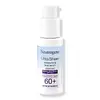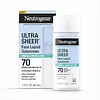What's inside
What's inside
 Key Ingredients
Key Ingredients

 Benefits
Benefits

 Concerns
Concerns

 Ingredients Side-by-side
Ingredients Side-by-side

Butyl Methoxydibenzoylmethane 3%
UV AbsorberHomosalate 13.5%
Skin ConditioningEthylhexyl Salicylate 5%
UV AbsorberOctocrylene 10%
UV AbsorberWater
Skin ConditioningButyloctyl Salicylate
Skin ConditioningGlycerin
HumectantAlcohol Denat.
AntimicrobialSilica
AbrasiveDimethicone
EmollientAluminum Starch Octenylsuccinate
AbsorbentPolyurethane-62
Phenoxyethanol
PreservativePentylene Glycol
Skin ConditioningSodium Acryloyldimethyltaurate/Vp Crosspolymer
Emulsion StabilisingAcrylates/Dimethicone Copolymer
Skin ConditioningGlyceryl Stearate
EmollientChlorphenesin
AntimicrobialStyrene/Acrylates Copolymer
Tocopheryl Acetate
AntioxidantDisodium EDTA
Trideceth-6
EmulsifyingSodium Hydroxide
BufferingButyl Methoxydibenzoylmethane 3%, Homosalate 13.5%, Ethylhexyl Salicylate 5%, Octocrylene 10%, Water, Butyloctyl Salicylate, Glycerin, Alcohol Denat., Silica, Dimethicone, Aluminum Starch Octenylsuccinate, Polyurethane-62, Phenoxyethanol, Pentylene Glycol, Sodium Acryloyldimethyltaurate/Vp Crosspolymer, Acrylates/Dimethicone Copolymer, Glyceryl Stearate, Chlorphenesin, Styrene/Acrylates Copolymer, Tocopheryl Acetate, Disodium EDTA, Trideceth-6, Sodium Hydroxide
Titanium Dioxide 6.6%
Cosmetic ColorantZinc Oxide 14.4%
Cosmetic ColorantWater
Skin ConditioningCaprylic/Capric Triglyceride
MaskingGlycerin
HumectantButyloctyl Salicylate
Skin ConditioningEthylhexyl Methoxycrylene
Skin ConditioningVp/Hexadecene Copolymer
Dimethicone
EmollientSteareth-21
CleansingCalcium Sodium Borosilicate
Triacontanyl Pvp
HumectantPolyhydroxystearic Acid
EmulsifyingAluminum Hydroxide
EmollientStearic Acid
CleansingTriethoxycaprylylsilane
Cetearyl Olivate
Phenoxyethanol
PreservativeSodium Chloride
MaskingXanthan Gum
EmulsifyingEthylhexylglycerin
Skin ConditioningSorbitan Olivate
EmulsifyingChlorphenesin
AntimicrobialCaprylyl Glycol
EmollientTocopheryl Acetate
AntioxidantDisodium EDTA
Titanium Dioxide 6.6%, Zinc Oxide 14.4%, Water, Caprylic/Capric Triglyceride, Glycerin, Butyloctyl Salicylate, Ethylhexyl Methoxycrylene, Vp/Hexadecene Copolymer, Dimethicone, Steareth-21, Calcium Sodium Borosilicate, Triacontanyl Pvp, Polyhydroxystearic Acid, Aluminum Hydroxide, Stearic Acid, Triethoxycaprylylsilane, Cetearyl Olivate, Phenoxyethanol, Sodium Chloride, Xanthan Gum, Ethylhexylglycerin, Sorbitan Olivate, Chlorphenesin, Caprylyl Glycol, Tocopheryl Acetate, Disodium EDTA
 Reviews
Reviews

Ingredients Explained
These ingredients are found in both products.
Ingredients higher up in an ingredient list are typically present in a larger amount.
Butyloctyl Salicylate is a chemical UV filter structurally similar to octisalate. It is a photostabilizer, SPF booster, emollient and solvent. This ingredient helps evenly spread out ingredients.
According to a manufacturer, it is suitable for pairing with micro Titanium Dioxide, Zinc Oxide, and pigments.
Photostabilizers help stabilize UV-filters and prevents them from degrading quickly.
Learn more about Butyloctyl SalicylateChlorphenesin is a synthetic preservative. It helps protect a product against bacteria in order to extend shelf life. In most cases, Chlorphenesin is paired with other preservatives such as phenoxyethanol and caprylyl glycol.
Chlorphenesin is a biocide. This means it is able to help fight the microorganisms on our skin. It is also able to fight odor-releasing bacteria.
Chlorphenesin is soluble in both water and glycerin.
Studies show Chlorphenesin is easily absorbed by our skin. You should speak with a skincare professional if you have concerns about using Chlorphenesin.
Learn more about ChlorphenesinDimethicone is a type of synthetic silicone created from natural materials such as quartz.
What it does:
Dimethicone comes in different viscosities:
Depending on the viscosity, dimethicone has different properties.
Ingredients lists don't always show which type is used, so we recommend reaching out to the brand if you have questions about the viscosity.
This ingredient is unlikely to cause irritation because it does not get absorbed into skin. However, people with silicone allergies should be careful about using this ingredient.
Note: Dimethicone may contribute to pilling. This is because it is not oil or water soluble, so pilling may occur when layered with products. When mixed with heavy oils in a formula, the outcome is also quite greasy.
Learn more about DimethiconeDisodium EDTA plays a role in making products more stable by aiding other preservatives.
It is a chelating agent, meaning it neutralizes metal ions that may be found in a product.
Disodium EDTA is a salt of edetic acid and is found to be safe in cosmetic ingredients.
Learn more about Disodium EDTAGlycerin is already naturally found in your skin. It helps moisturize and protect your skin.
A study from 2016 found glycerin to be more effective as a humectant than AHAs and hyaluronic acid.
As a humectant, it helps the skin stay hydrated by pulling moisture to your skin. The low molecular weight of glycerin allows it to pull moisture into the deeper layers of your skin.
Hydrated skin improves your skin barrier; Your skin barrier helps protect against irritants and bacteria.
Glycerin has also been found to have antimicrobial and antiviral properties. Due to these properties, glycerin is often used in wound and burn treatments.
In cosmetics, glycerin is usually derived from plants such as soybean or palm. However, it can also be sourced from animals, such as tallow or animal fat.
This ingredient is organic, colorless, odorless, and non-toxic.
Glycerin is the name for this ingredient in American English. British English uses Glycerol/Glycerine.
Learn more about GlycerinPhenoxyethanol is a preservative that has germicide, antimicrobial, and aromatic properties. Studies show that phenoxyethanol can prevent microbial growth. By itself, it has a scent that is similar to that of a rose.
It's often used in formulations along with Caprylyl Glycol to preserve the shelf life of products.
Tocopheryl Acetate is AKA Vitamin E. It is an antioxidant and protects your skin from free radicals. Free radicals damage the skin by breaking down collagen.
One study found using Tocopheryl Acetate with Vitamin C decreased the number of sunburned cells.
Tocopheryl Acetate is commonly found in both skincare and dietary supplements.
Learn more about Tocopheryl AcetateWater. It's the most common cosmetic ingredient of all. You'll usually see it at the top of ingredient lists, meaning that it makes up the largest part of the product.
So why is it so popular? Water most often acts as a solvent - this means that it helps dissolve other ingredients into the formulation.
You'll also recognize water as that liquid we all need to stay alive. If you see this, drink a glass of water. Stay hydrated!
Learn more about Water